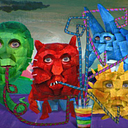My mind seems to work better in a visual context; I relate to patterns much more readily than to other more abstract approaches.
This is fine though, because the rise of modern computer technology, means it has never been easier to model, map and visualize some of the most complex relationships ‘thrown up’ by this world.
The ‘pattern-seeking me’ is drawn to some of the current theories linking the ‘E8’ multidimensional ‘object’ to the interactions of the fundamental particles of the physical world.
The E8 can be thought of as the densest most efficient way of packing 8 dimensional spheres in an 8 dimensional space; (The ‘E8 crystal lattice’ is formed by drawing lines between neighbouring points where the packed spheres would come into contact with each other.)
This E8 lattice structure is unique. If you imagine a large mirror in front of you and another behind, the reflections would disappear away to infinity. In this lattice though, the angles are 60 degrees to one another so they only reflect a finite number of times.
The E8 lattice is the most complex lattice possible where none of its reflections disappear away to infinity. This makes it a very important algebra tool, providing results that can be pinned down and do not race away across the horizon.
The E8 has a 248-dimensional symmetry, but these dimensions are not necessarily spatial, like the three dimensions we live in; they correspond to mathematical degrees of freedom, with each dimension representing a different variable.
Recently a supercomputer mapped the E8. It took 77 hours of computing time, resulted in a matrix of 453,060 x453,060 cells, containing more than 205 billion entries.
Using massive particle accelerators, physicists have discovered 226 elementary particles so far, with a variety of spins and charges.
If these are plotted out according to their charges some very interesting patterns emerge.
In order to be able to assign unique charges to each of these particles then these values need to be plotted onto an eight dimensional ‘charge space’.
The patterns and rotations of the ‘shape’ thus formed (in ‘charge space’) summarises thousands of possible interactions between these elementary particles.
Theorists have sought to unify and overlay these patterns; Relating each elementary particle point to a distinct symmetry of the E8 lattice.
With a particular rotation we can look down through this pattern, (through the 8 dimensions) and see all the particles at once. (see cover photo)
We have only discovered 226 elementary particles, so there are 22 gaps on the E8's 248-dimensional symmetry.
Theorists, seeking to unify these elements, postulate that other elementary particles as yet undiscovered, must lie in these seemingly empty spaces.
This may well be realised as the energy levels used in the large particle accelerators increases, and new particles are discovered.
The E8 lattice has an analogous crystal form, created by slicing a section out of E8 and projecting it onto a lower dimension. For instance, when projected onto 4 dimensions, you get a ‘quasi-crystal’ made up of nothing but regular 3-dimensional tetrahedra in 4 dimensions.
The combinations and permutations of quasi-crystal can be thought of as a sort of Mosaic tiling code.
They can be arranged in creative ways; There is a syntactical freedom in how the tiles can be rearranged, within rules. This arrangement becomes a language or code made up of geometrical shapes.
These quasi-crystals are projected; It is this ‘Projection’ of the E8 that is transformative!
Like when a lattice cube is held up to the sun; It projects a shadow on to the ground. The shadow has different angles and lengths of lines to that of the original cube. It has been transformed and movement of the shape creates different lines and angles, but if you have knowledge of geometry, you can unpack or recover the information of the full cube from the shadow
The quasi-crystal is the 3 dimensional shadow of an 8 dimensional crystal slice
Such quasi-crystals are actually more complicated than the higher dimensional crystal mother from which they were ‘born’
The reason for this is that they are really a product of two parents. The mother crystal and the father ‘projector’.
The projector is a special object. An angle and hyper vector; a hyper projector.
It is easy to muse that our 3 dimensional world may well be a sort of shadow play, like the allegory of plato’s cave.
The constantly moving and recombining shadows of a multidimensional object projected onto a lower dimensional world. The product being a creative, mosaic tiling language.
